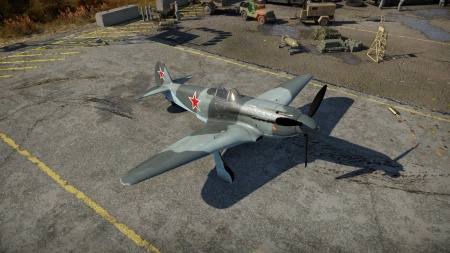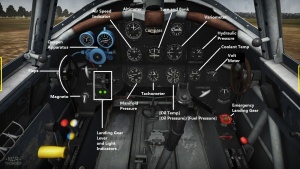Yak-3
Contents
Description
The Yak-3 is a Rank III Soviet fighter with a battle rating of 4.0 (AB/RB) and 4.7 (SB). It was in the game since the start of the Open Beta Test prior to Update 1.29.
By the time you get this plane, you should be well versed in the rules of Yakovlev warfare: Engine throttle at about 90%, stay below 2000m, and watch your ammo. However, the Yak-3 is a true gift to Soviet pilots: while peak performance is still at or below 2000m, going above up to 4000m is now possible! Energy fighting, while not the Yak's specialty, can also be done effectively with the Yak-3, and moderate BnZ can be allowed due to metal wing construction (wings take more to rip now). While engine throttle should still be at 90% for max engine cooling, once upgraded, you should never have to throttle lower than this on this plane. In addition, WEP is moderately effective now and does not overheat the engine as fast as previous Yaks!
The guns on this plane are worth noting as well. Along with the effective and feared 20mm cannon in the nose, the Yak-3 gains an additional 12.7 MG. This means that the cannon is no longer your only real weapon. Dual 50.s can wreak impressive havoc at close range, and compliment the cannon well. The cannon also gets an improved belt: Air Targets. While not having as much HE as the Ground Targets belt (some pilots will, justifiably, prefer the GT belt), but it contains more incendiary rounds. The Stealth belt is still a solid choice for those who are used to the trajectory of the cannon. Find the belt that suits you.
The Yak-3 sports 2x Berezin UB 12.7mm MG's, which are arguably the best 12.7mm weapons in the game besides the M3 browning. These run dry at approximately the same time as the 20mm ShVAK cannon. The ShVAK sports inferior ballistics to those of the MG-151 and especially Hispano cannons, closing to short range before firing is recommended. Being hub mounted, the ShVAK can utilize it's hefty firing rate advantage that it holds over all 20mm cannons in the game (with the exception of the F-86F-2's T-160s).
The Yak-3 carries 150 RPG for the Berezin UB and 120 rounds for the ShVAK, which is a below average load. It is imperative that you fire short bursts and save your ammo until below 400 meters for maximum effectiveness and longevity. This weapon set is more than adequate for fighter vs. fighter engagements, but you will notice how lacking the weapons are vs. dual and quad engine aircraft.
The lightened airframe of the Yak-3, being propelled by the more powerful Klimov VK-105 engine, gives the aircraft very good acceleration properties and a good rate of climb. It is also very agile, especially at low altitudes. However, while the Yak-3 is one of the best low-altitude dogfighters, its high-altitude performance still leaves much to be desired. The aircraft should always be kept below 4 km altitude to maximize its strengths. The Yak can also be used as a Boom & Zoom aircraft, however due to low wing endurance it is advised to always control the speed of the dive and not use excessive force to pull out of it.
General info
Flight Performance
Stat card
| Characteristics | |||||||
|---|---|---|---|---|---|---|---|
| Stock | |||||||
| Max Speed (km/h at 4,100 m) |
Max altitude (meters) |
Turn time (seconds) |
Rate of climb (meters/second) |
Take-off run (meters) | |||
| AB | RB | AB | RB | AB | RB | ||
| 663 | 646 | 10,400 | 18.2 | 18.8 | 17.9 | 17.9 | 348 |
| Upgraded | |||||||
| Max Speed (km/h at 4,100 m) |
Max altitude (meters) |
Turn time (seconds) |
Rate of climb (meters/second) |
Take-off run (meters) | |||
| AB | RB | AB | RB | AB | RB | ||
| ___ | 654 | 10,400 | __.__ | 17.4 | __.__ | 21.3 | 348 |
Details
| Features | ||||
|---|---|---|---|---|
| Combat flap | Take-off flap | Landing flap | Air brakes | Arrestor gear |
| X | X | ✓ | X | X |
| Limits | ||||
|---|---|---|---|---|
| Wing-break speed (km/h) |
Gear limit (km/h) |
Combat flap (km/h) |
Max Static G | |
| + | - | |||
| 685 | 320 | 520 | ~23 | ~18 |
| Optimal velocities | |||
|---|---|---|---|
| Ailerons (km/h) |
Rudder (km/h) |
Elevators (km/h) |
Radiator (km/h) |
| < 380 | < 420 | < 490 | > 270 |
| Compressor (RB/SB) | ||
|---|---|---|
| Setting 1 | ||
| Optimal altitude | 100% Engine power | |
| 300 m | 1,310 hp | |
| Setting 2 | ||
| Optimal altitude | 100% Engine power | WEP Engine power |
| 2,600 m | 1,240 hp | |
Engine performance
| Engine | |||||
|---|---|---|---|---|---|
| Engine Name | Number present | ||||
| Klimov VK-105PF 12-cylinder | 1 | ||||
| Engine characteristics | |||||
| Weight (each) | Type | Cooling | |||
| 600 kg | Inline | Water | |||
| Engine power (Stock) | |||||
| Mode | Take-off | ||||
| Arcade | 1,229 hp | ||||
| Realistic/Simulator | 1,217 hp | ||||
| Engine power (Upgraded) | |||||
| Mode | Mode | Take-off | |||
| Arcade | ____ hp | ||||
| Realistic/Simulator | 1,320 hp | ||||
| WEP Duration | |||
|---|---|---|---|
| Arcade | Realistic/Simulator | ||
| 25 seconds | N/A | ||
Survivability and armour
Examine the survivability of the aircraft. Note how vulnerable the structure is and how secure the pilot is, whether the fuel tanks are armoured. Describe the armour, if there is any, also mention the vulnerability of other critical aircraft systems.
Armaments
Offensive armament
The Yak-3 is armed with:
- 1 x 20 mm ShVAK cannon, nose-mounted (120 rpg)
- 2 x 12.7 mm Berezin UB machine gun, nose-mounted (150 rpg = 300 total)
Usage in the battles
The Yak-3 is the pinnacle of the piston engine Yakovlev design, with a much more powerful engine, the addition of a second MG (meaning the MGs are viable now!), and metal wings! The coolant system, now actually somewhat effective, has been moved to the wing roots (no "smiley face" below the nose), making the plane more streamlined. The cannon - the same old 20mm ShVak - receives a pleasant upgrade: an effective Air Targets belt.
Overall, the Yak-3 can be considered as a "jack-of-all-trades, master-of-none" aircraft. It will readily fulfill any fighter role a pilot will put it in, however it won't excel in any – the American and German aircraft will still be better at energy fighting and executing Boom & Zoom tactics, while the British and the Japanese planes will still have an edge in maneuverability. Yet, the Yak-3 is a very potent machine which, with a skilled pilot behind the controls, is an opponent that you don't want to underestimate.
Baiting higher enemies into lower altitudes and engaging them in a dogfight is a worthwile tactic. The only exception to this are Japanese opponents and certain Spitfire variants, where strict energy fighting or boom and zoom is recommended.
The Yak series also works oddly well in medium altitude "Boom 'n Zoom", thanks to a clean low drag airframe (good horizontal energy retention) and good vertical maneuverability.
Manual Engine Control
| MEC elements | ||||||
|---|---|---|---|---|---|---|
| Mixer | Pitch | Radiator | Supercharger | Turbocharger | ||
| Oil | Water | Type | ||||
| Controllable | Controllable No automatic pitch |
Controllable | Controllable | Separate | Controllable | Not controllable |
Pros and cons
Pros:
- Very Maneuverable.
- Excellent roll rate.
- High acceleration and top speed, especially at low altitudes.
- Excellent energy retention.
- Dual Berezin UB HMG's with upgraded belts are capable of doing good damage.
Cons:
- Still confers to the standard Yak setup of 1x20 mm ShVaK with one/two MGs, which is underwhelming at this tier.
- Poor high altitude performance.
- Upgraded Yak-3s can still have engine overheating problems!
History
The idea to produce a new fighter for the Red Army Air Force went as far back as 1941. It was then that the Yakovlev Design Bureau presented the I-30 prototype, intended an alternative to the earlier Yak-1 design. However, the German invasion of the USSR as well as aluminum shortages meant that the project had to be put on hold. Yakovlev resumed the development in 1943 while working on an upgraded version of the Yak-1 fighter. This time, it was decided that a new aircraft should be produced to completely replace the Yak-1 and Yak-7 models. The new machine was dubbed as the Yak-3 and entered service with the Red Army Air Force in 1944.
The new fighter quickly became very popular with Soviet pilots. They highly praised its solid armament of two Berezin UBS 12.7 mm machine guns and one ShVAK 20 mm cannon as well as ease of piloting and superb low-altitude performance. Marcel Albert, the top scoring French ace of World War II, cited the Yak-3 as one of the best fighters of the war, along with the P-51 Mustang and the Supermarine Spitfire. After the war the Yak-3 was also used by the Air Forces of Socialist Yugoslavia and Poland.[1]
Produced from April 1945 until mid-1946, armed with 3 × 20 mm Berezin B-20 cannon with 120 rounds for the middle cannon and 130 rpg for the side weapons. The three-cannon armament with full ammunition load was actually 11 kg (24 lb) lighter than that of a standard Yak-3, and the one-second burst mass of 3.52 kg (7.74 lb) was greater than that of most contemporary fighters. Starting in August 1945, all Yak-3 were produced in the Yak-3P configuration with a total of 596 built.
Media
Skins and camouflages for the Yak-3 from http://live.warthunder.com
References
Read also
[Aircraft Profile] Yak-3
[News] Wings of Victory: Yak-3
Sources
Paste links to sources and external resources, such as:
- topic on the official game forum;
- page on aircraft encyclopedia;
- other literature.
| USSR fighters | |
|---|---|
| I-15 | I-15 WR · I-15 M-22 · I-15 M-25 · I-15bis · Krasnolutsky's I-15bis |
| I-153 M-62 · Zhukovsky's I-153-M62 · I-153P | |
| I-16 | I-16 type 5 · I-16 type 10 · I-16 type 18 · I-16 type 24 · I-16 type 27 · I-16 type 28 · I-180S |
| I-29 | I-29 |
| I-185 | I-185 (M-71) · I-185 (M-82) |
| I-225 | I-225 |
| ITP | ITP (M-1) |
| MiG-3 | MiG-3-15 · MiG-3-15 (BK) · MiG-3-34 |
| LaGG | I-301 · LaGG-3-4 · LaGG-3-8 · LaGG-3-11 · LaGG-3-23 · LaGG-3-34 · LaGG-3-35 · LaGG-3-66 |
| La | La-5 · La-5F · La-5FN · La-7 · Dolgushin's La-7 · La-7B-20 · La-9 · La-11 |
| Yak-1/7 | Yak-1 · Yak-1B · Yak-7B |
| Yak-3 | Yak-3 · Eremin's Yak-3(e) · Yak-3P · Yak-3T · Yak-3U · Yak-3 (VK-107) |
| Yak-9 | Yak-9 · Yak-9B · Golovachev's Yak-9M · Yak-9T · Yak-9K · Yak-9U · Yak-9UT · Yak-9P |
| Other countries | ▂P-40E-1 · ▂P-47D-27 · ▂Hurricane Mk IIB · ▂Fw 190 D-9 · ▂Spitfire Mk IXc |
| P-39 | ▂P-39K-1 · ▂Pokryshkin's P-39N-0 · ▂P-39Q-15 |
| P-63 | ▂P-63A-5 · ▂P-63A-10 · ▂P-63C-5 |






